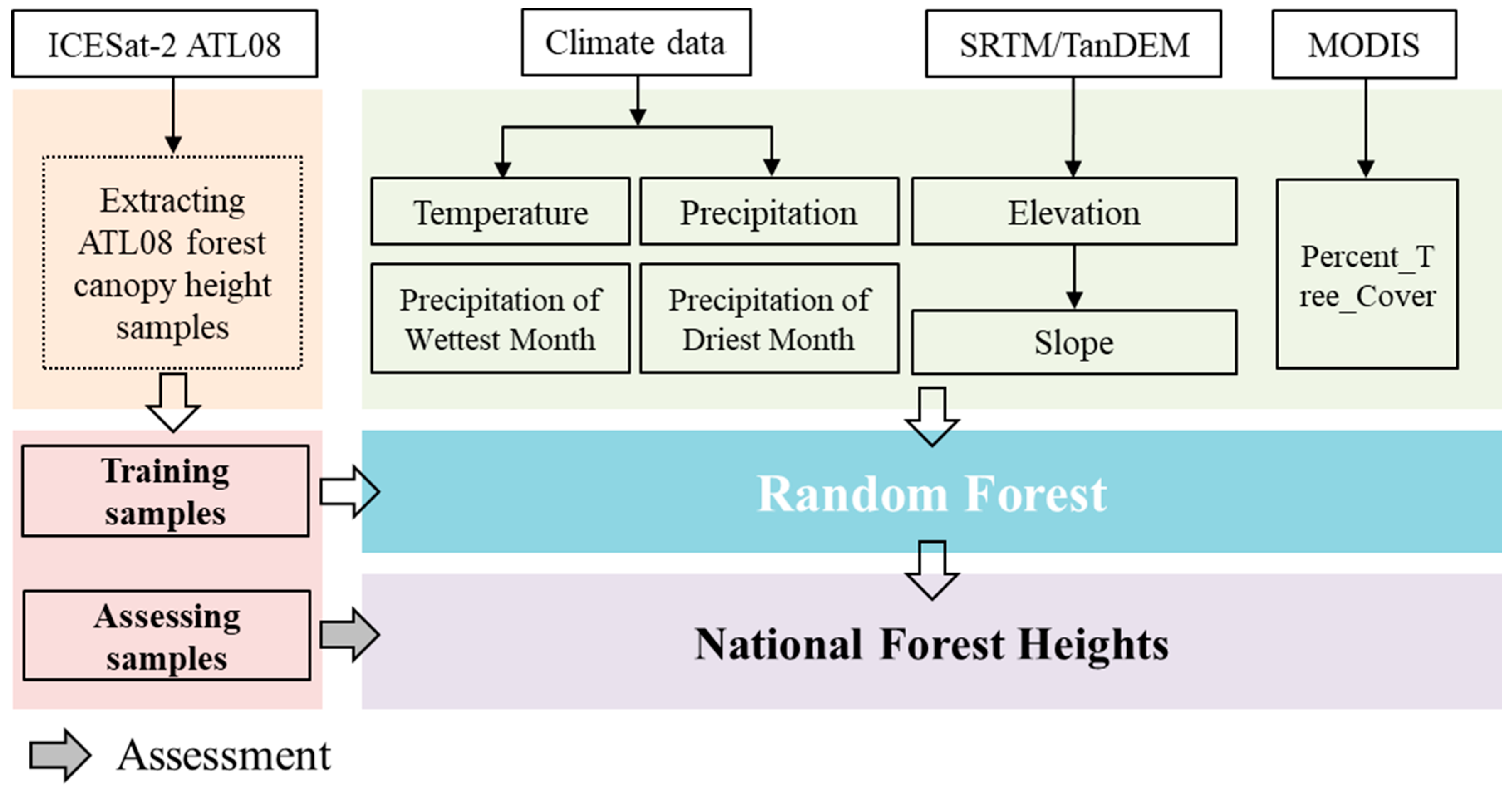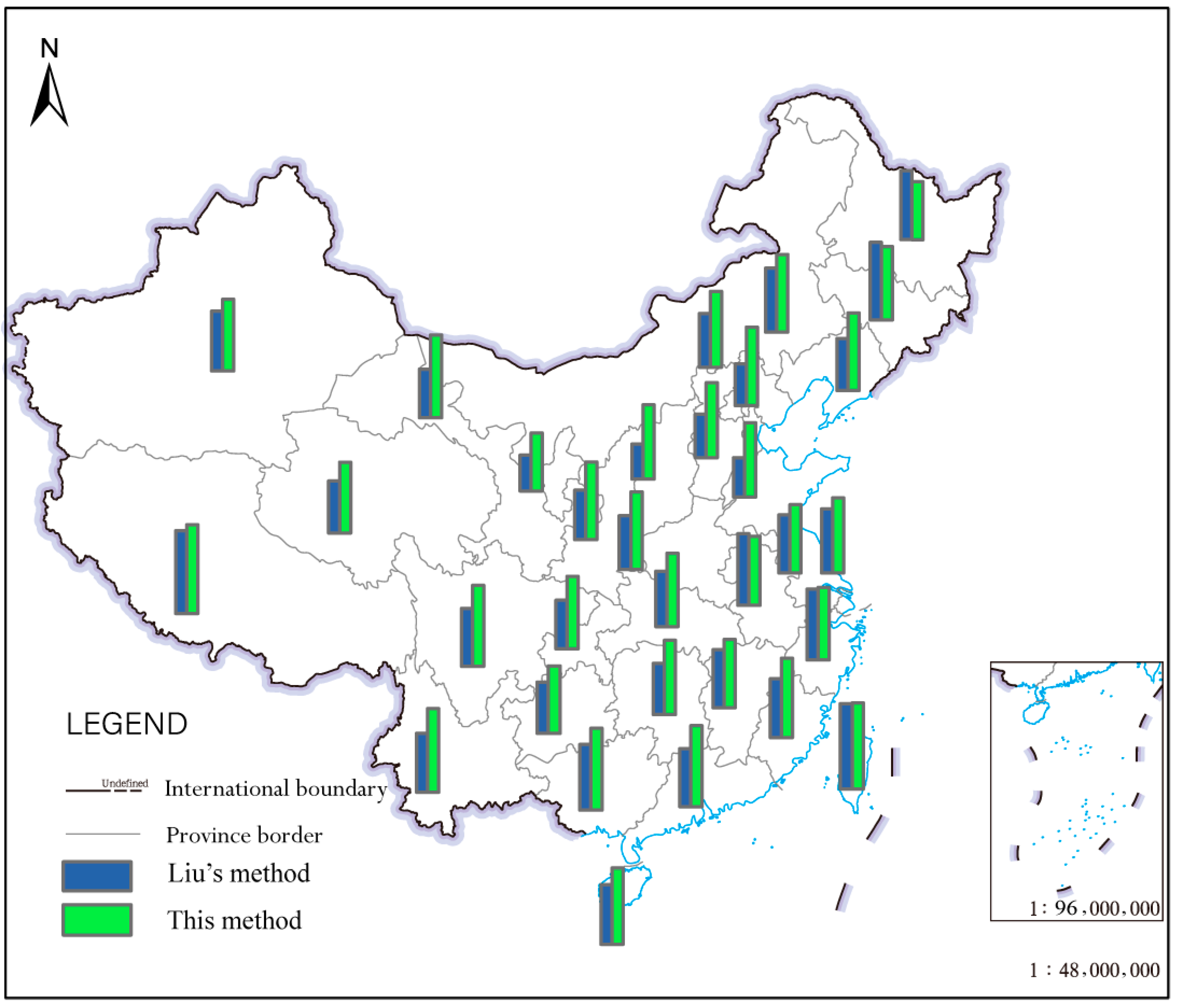A Rapid and Easy Way for National Forest Heights Retrieval in China Using ICESat-2/ATL08 in 2019
Abstract
1. Introduction
2. Materials and Methods
2.1. Data
2.1.1. ICESat-2/ATLAS Data
2.1.2. Climate Data
2.1.3. MODIS VCF
2.1.4. TanDEM-X DEM/SRTM DEM
2.2. Methods
2.2.1. Extracting the Forest Height from ICESat-2/ATLAS
2.2.2. Mapping Wall-to-Wall Forest Height by Random Forest
2.2.3. Assessment
3. Results and Discussion
3.1. National Forest Height Map and Accuracy Assessment
3.2. Forest Heights on a Province Scale
3.3. Limitations
4. Conclusions
Author Contributions
Funding
Data Availability Statement
Conflicts of Interest
References
- Zhu, X.X.; Wang, C.; Nie, S.; Pan, F.F.; Xi, X.H.; Hu, Z.Y. Mapping forest height using photon-counting LiDAR data and Landsat 8 OLI data: A case study in Virginia and North Carolina, USA. Remote Sens. Environ. 2020, 114, 106287. [Google Scholar] [CrossRef]
- Li, W.; Niu, Z.; Shang, R.; Qin, Y.C.; Wang, L.; Chen, H.Y. High-resolution mapping of forest canopy height using machine learning by coupling ICESat-2 LiDAR with Sentinel-1, Sentinel-2 and Landsat-8 data. Int. J. Appl. Earth Obs. Geoinf. 2020, 92, 102163. [Google Scholar] [CrossRef]
- Huang, H.B.; Liu, C.X.; Wang, X.Y. Constructing a Finer-Resolution Forest Height in China Using ICESat/GLAS, Landsat and ALOS PALSAR Data and Height Patterns of Natural Forests and Plantations. Remote Sens. 2019, 11, 1740. [Google Scholar] [CrossRef]
- Francini, S.; D’AMICO, G.; Vangi, E.; Borghi, C.; Chirici, G. Integrating GEDI and Landsat: Spaceborne lidar and four decades of optical imagery for the analysis of forest disturbances and biomass changes in Italy. Sensors 2022, 22, 2015. [Google Scholar] [PubMed]
- Mohamed, M.; Gulab, S. Improving Forest Above-Ground Biomass Retrieval Using Multi-Sensor L- and C- Band SAR Data and Multi-Temporal Spaceborne LiDAR Data. Front. For. Glob. Chang. 2022, 5, 822704. [Google Scholar]
- Duncanson, L.; Dubayah, R. Monitoring individual tree-based change with airborne lidar. Ecol. Evol. 2018, 8, 5079–5089. [Google Scholar] [CrossRef] [PubMed]
- Lefsky, M.A. A global forest canopy height map from the moderate resolution imaging Spectroradiometer and the geoscience laser altimeter system. Geophys. Res. Lett. 2010, 37, L15401. [Google Scholar] [CrossRef]
- Wang, Y.Y.; Li, G.C.; Ding, H.H.; Guo, Z.D.; Tang, S.H.; Wang, C.; Huang, Q.N.; Liu, R.G.; Chen, J.M. A combined GLAS and MODIS estimation of the global distribution of mean forest canopy height. Remote Sens. Environ. 2016, 174, 24–43. [Google Scholar] [CrossRef]
- Vauhkonen, J.; Ene, L.; Gupta, S.; Heinzel, J.; Holmgren, J.; Pitkanen, J.; Solberg, S.; Wang, Y.S.; Weinacker, H.; Hauglini, K.M.; et al. Comparative testing of single-tree detection algorithms under different types of forest. Forestry 2012, 85, 27–40. [Google Scholar] [CrossRef]
- Bollandsas, O.M.; Gregoire, T.G.; Nasset, E.; Oyen, B.H. Detection of biomass change in a Norwegian mountain forest area using small footprint airborne laser scanner data. Stat. Methods Appl. 2013, 22, 113–129. [Google Scholar] [CrossRef]
- Potapov, P.; Li, X.Y.; Hernandez-serna, A.; Tyukavina, A.; Hansen, M.C.; Kommareddy, A.; Pickens, A.; Turubanova, S.; Tang, H.; Silva, C.E. Mapping global forest canopy height through integration of GEDI and Landsat data. Remote Sens. Environ. 2021, 253, 112165. [Google Scholar] [CrossRef]
- Simard, M.; Pinto, N.; Fisher, J.B.; Baccini, A. Mapping forest canopy height globally with spaceborne lidar. J. Geophys. Res.-Biogeosci. 2011, 116, 4021. [Google Scholar] [CrossRef]
- Popescu, S.C.; Zhou, T.; Nelson, R.; Neuenschwander, A.; Sheridan, R.; Narine, L.; Walsh, K.M. Photon counting LiDAR: An adaptive ground and canopy height retrieval algorithm for ICESat-2 data. Remote Sens. Environ. 2018, 208, 154–170. [Google Scholar] [CrossRef]
- Sun, T.; Qi, J.B.; Huang, H.G. Discovering forest height changes based on spaceborne lidar data of ICESat-1 in 2005 and ICESat-2 in 2019: A case study in the Beijing-Tianjin-Hebei region of China. For. Ecosyst. 2020, 7, 53. [Google Scholar] [CrossRef]
- Yang, T.; Wang, C.; Li, G.C.; Luo, S.Z.; Xi, X.H.; Gao, S.; Zeng, H.C. Forest canopy height mapping over China using GLAS and MODIS data. Sci. China Earth Sci. 2014, 44, 2487–2498. [Google Scholar]
- Liu, X.Q.; Su, Y.J.; Hu, T.Y.; Yang, Q.L.; Liu, B.B.; Deng, Y.F.; Tang, H.; Tang, Z.Y.; Fang, J.Y.; Guo, Q.H. Neural network guided interpolation for mapping canopy height of China’s forests by integrating GEDI and ICESat-2 data. Remote Sens. Environ. 2022, 269, 112844. [Google Scholar] [CrossRef]
- Neuenschwander, A.; Pitts, K. The ATL08 land and vegetation product for the ICESat-2 Mission. Remote Sens. Environ. 2019, 221, 247–259. [Google Scholar] [CrossRef]
- Neuenschwander, A.L.; Magruder, L.A. The potential impact of vertical sampling uncertainty on ICESat-2/ATLAS terrain and canopy height retrievals for multiple ecosystems. Remote Sens. 2016, 8, 1039. [Google Scholar] [CrossRef]
- Huang, H.; Liu, C.; Wang, X.; Biging, G.S.; Chen, Y.; Yang, J.; Gong, P. Mapping vegetation heights in China using slope correction ICESat data, SRTM, MODIS-derived and climate data. ISPRS J. Photogramm. Remote Sens. 2017, 129, 189–199. [Google Scholar] [CrossRef]
- Liu, A.B.; Cheng, X.; Chen, Z.Q. Performance evaluation of GEDI and ICESat-2 laser altimeter data for terrain and canopy height retrievals. Remote Sens. Environ. 2021, 264, 112571. [Google Scholar] [CrossRef]




| Variable | Dataset | Year | Resolution |
|---|---|---|---|
| Elevation | SRTM/TanDEM-X | 2000/2015 | 90 m |
| Slope | SRTM/TanDEM-X | 2000/2015 | 90 m |
| Percent_Tree_Cover | MOD44B | 2019 | 250 m |
| Annual Mean Temperature | Worldclim | 1970–2000 | 30 s |
| Annual Mean Precipitation | Worldclim | 1970–2000 | 30 s |
| Temperature Seasonality | Worldclim | 1970–2000 | 30 s |
| Precipitation Seasonality | Worldclim | 1970–2000 | 30 s |
| Precipitation of Wettest Month | Worldclim | 1970–2000 | 30 s |
| Precipitation of Driest Month | Worldclim | 1970–2000 | 30 s |
| Max Temperature of Warmest Month | Worldclim | 1970–2000 | 30 s |
| Min Temperature of Coldest Month | Worldclim | 1970–2000 | 30 s |
| Province | Mean Canopy Height by This Method (m) | Liu’s Method (m) |
|---|---|---|
| Heilongjiang | 13 | 15.45 |
| Inner Mongolia | 12.91 | 14.26 |
| Jilin | 16.26 | 17.39 |
| Anhui | 15.39 | 15.95 |
| Taiwan | 19.26 | 19.03 |
| Zhejiang | 16.26 | 15.98 |
| Tibet | 19.9 | 18.49 |
| Jiangxi | 15.28 | 12.99 |
| Jiangsu | 15.28 | 12.91 |
| Shanghai | 16.64 | 14.23 |
| Xinjiang | 16.14 | 13.31 |
| Guizhou | 15.04 | 11.46 |
| Guangxi | 18.37 | 14.76 |
| Hainan | 17.12 | 13.45 |
| Hubei | 16.35 | 12.35 |
| Qinghai | 15.84 | 11.48 |
| Fujian | 17.72 | 13.14 |
| Ningxia | 12.9 | 7.93 |
| Beijing | 17.17 | 12.19 |
| Sichuan | 18.06 | 13.03 |
| Hunan | 16.65 | 11.47 |
| Guangdong | 18.26 | 13.018 |
| Henan | 17.51 | 12.22 |
| Chongqing | 16.28 | 10.96 |
| Yunnan | 18.7 | 13.3 |
| Liaoning | 17.33 | 11.69 |
| Shaanxi | 17.43 | 11.08 |
| Hebei | 16.63 | 9.62 |
| Gansu | 18.42 | 10.78 |
| Shandong | 16.71 | 8.77 |
| Tianjin | 17.71 | 9.35 |
| Shanxi | 16.68 | 7.93 |
Disclaimer/Publisher’s Note: The statements, opinions and data contained in all publications are solely those of the individual author(s) and contributor(s) and not of MDPI and/or the editor(s). MDPI and/or the editor(s) disclaim responsibility for any injury to people or property resulting from any ideas, methods, instructions or products referred to in the content. |
© 2023 by the authors. Licensee MDPI, Basel, Switzerland. This article is an open access article distributed under the terms and conditions of the Creative Commons Attribution (CC BY) license (https://creativecommons.org/licenses/by/4.0/).
Share and Cite
Gao, S.; Zhu, J.; Fu, H. A Rapid and Easy Way for National Forest Heights Retrieval in China Using ICESat-2/ATL08 in 2019. Forests 2023, 14, 1270. https://doi.org/10.3390/f14061270
Gao S, Zhu J, Fu H. A Rapid and Easy Way for National Forest Heights Retrieval in China Using ICESat-2/ATL08 in 2019. Forests. 2023; 14(6):1270. https://doi.org/10.3390/f14061270
Chicago/Turabian StyleGao, Shijuan, Jianjun Zhu, and Haiqiang Fu. 2023. "A Rapid and Easy Way for National Forest Heights Retrieval in China Using ICESat-2/ATL08 in 2019" Forests 14, no. 6: 1270. https://doi.org/10.3390/f14061270
APA StyleGao, S., Zhu, J., & Fu, H. (2023). A Rapid and Easy Way for National Forest Heights Retrieval in China Using ICESat-2/ATL08 in 2019. Forests, 14(6), 1270. https://doi.org/10.3390/f14061270






